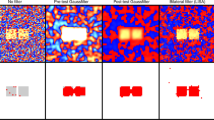Abstract
Although spatial smoothing of fMRI data can serve multiple purposes, increasing the sensitivity of activation detection is probably its greatest benefit. However, this increased detection power comes with a loss of specificity when non-adaptive smoothing (i.e. the standard in most software packages) is used. Simulation studies and analysis of experimental data was performed using the R packages neuRosim and fmri. In these studies, we systematically investigated the effect of spatial smoothing on the power and number of false positives in two particular cases that are often encountered in fMRI research: (1) Single condition activation detection for regions that differ in size, and (2) multiple condition activation detection for neighbouring regions. Our results demonstrate that adaptive smoothing is superior in both cases because less false positives are introduced by the spatial smoothing process compared to standard Gaussian smoothing or FDR inference of unsmoothed data.







Similar content being viewed by others
Notes
We explicitly discard cluster-based FDR methods (e.g. Chumbley and Friston 2009) because they are also dependent on RFT inference.
The influence of spatial smoothing in this stage was minimized by setting the FWHM of the Gaussian smoothing kernel to 1 mm, before estimating the realignment parameters.
References
Adler, R. (2000). On excursion sets, tube formulae, and maxima of random fields (special invited paper). Annals of Applied Probability, 10, 1–74.
Benjamini, Y., & Hochberg, Y. (1995). Controlling the false discovery rate: a practical and powerful approach to multiple testing. Journal of the Royal Statistical Society, Series B, 57, 289–300.
Benjamini, Y., & Yekutieli, D. (2001). The control of the false discovery rate in multiple testing under dependency. The Annals of Statistics, 29, 1165–1188.
Carp, J. (2012). The secret lives of experiments: methods reporting in the fMRI literature. NeuroImage, 63, 289–300.
Chumbley, J., & Friston, K. (2009). False discovery rate revisited: Fdr and topological inference using gaussian random fields. NeuroImage, 44, 62–70.
Descombes, X., Kruggel, F., von Cramon, D. (1998). Spatio-temporal fMRI analysis using markov random fields. IEEE Transactions on Medical Imaging, 17, 1028–29.
Dümbgen, L., & Spokoiny, V. (2001). Multiscale testing of qualitative hypotheses. Annals of Statistics, 29, 124–152.
Friston, K., Worsley, K., Frackowiak, R., Mazziotta, J., Evans, A. (1994). Assessing the significance of focal activations using their spatial extent. Human Brain Mapping, 1, 214–220.
Friston, K., Ashburner, J., Kiebel, S., Nichols, T., Penny, W. (2007). Statistical parametric mapping: The analysis of functional brain images. Massachussets: Academic Press.
Harrison, L., Penny, W., Daunizeau, J., Friston, K. (2008). Diffusion-based spatial priors for functional magnetic resonance images. NeuroImage, 41, 408–423.
Logan, B., & Rowe, D. (2004). An evaluation of thresholding techniques in fMRI analysis. NeuroImage, 22, 95–108.
Lu, Y., Jiang, T., Zang, Y. (2003). Region growing method for the analysis of functional mri data. NeuroImage, 20, 455–465.
Poldrack, R., Mumford, J., Nichols, T. (2011). Handbook of functional MRI data analysis. New York: Cambridge University Press.
Poline, J., & Mazoyer, B. (1994). Enhanced detection in brain activation maps using a multifiltering approach. Journal of Cerebral Blood Flow Metabolism, 14, 639–642.
Polzehl, J., & Spokoiny, V. (2006). Propagation-separation approach for local likelihood estimation. Probability Theory and Relative Fields, 135, 335–362.
Polzehl, J., Voss, H., Tabelow, K. (2010). Structural adaptive segmentation for statistical parametric mapping. NeuroImage, 52, 515–523.
R Development Core Team (2010). R: a Language and Environment for Statistical Computing. R Foundation for Statistical Computing. Vienna, http://www.R-project.org, ISBN 3-900051-07-0.
Rosenfeld, A., & Kak, A. (1982). Digital picture processing 2. Orlando: Academic Press.
Seurinck, R., de Lange, F., Achten, E., Vingerhoets, G. (2011). Mental rotation meets the motion aftereffect: the role of hV5/MT+ in visual mental imagery. Journal of Cognitive Neuroscience, 23, 1395–1404.
Tabelow, K., & Polzehl, J. (2011). Statistical parametric maps for functional MRI experiments in r: the package fmri. Journal of Statistical Software, 44, 1–21.
Tabelow, K., Polzehl, J., Voss, H., Spokoiny, V. (2006). Analyzing fMRI experiments with structural adaptive smoothing procedures. NeuroImage, 33, 55–62.
Welvaert, M., & Rosseel, Y. (2012). How ignoring physiological noise can bias the conclusions from fMRI simulation studies. Journal of Neuroscience Methods, 211, 125–132.
Welvaert, M., Durnez, J., Moerkerke, B., Verdoolaege, G., Rosseel, Y. (2011). neuRosim: an R package for generating fMRI data. Journal of Statistical Software, 44, 1–18.
Worsley, K. (1994). Local maxima and the expected euler characteristic of excursion sets of χ 2, f and t fields. Advances in Applied Probability, 26, 13–42.
Worsley, K. (2003). Detecting activation in fmri data. Statistical Methods in Medical Research, 12, 401–418.
Yue, Y., Loh, J., Lindquist, M. (2010). Adaptive spatial smoothing of fmri images. Statistics and Its Interface, 3, 3–13.
Author information
Authors and Affiliations
Corresponding author
Additional information
Conflict of interests
The authors declare that they have no conflict of interest.
Rights and permissions
About this article
Cite this article
Welvaert, M., Tabelow, K., Seurinck, R. et al. Adaptive Smoothing as Inference Strategy. Neuroinform 11, 435–445 (2013). https://doi.org/10.1007/s12021-013-9196-z
Published:
Issue Date:
DOI: https://doi.org/10.1007/s12021-013-9196-z




